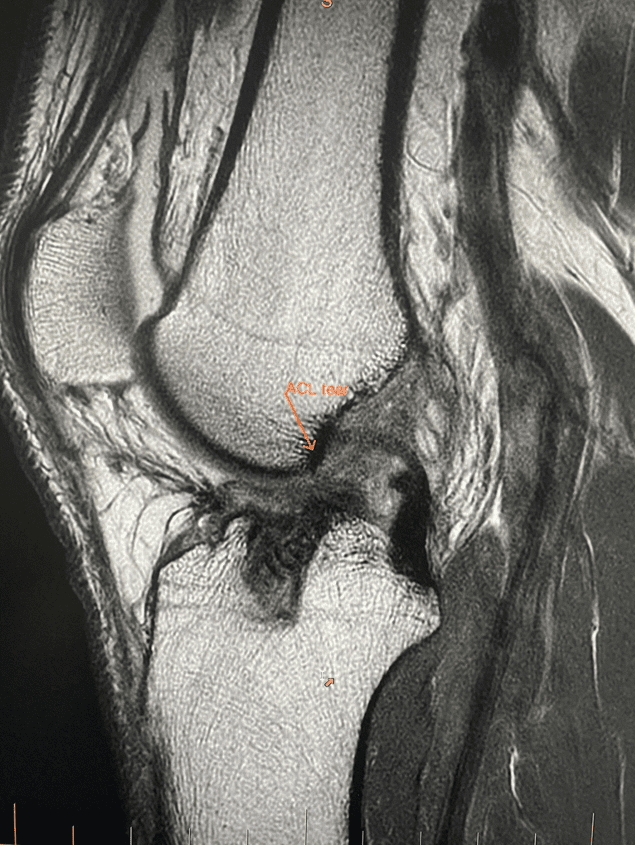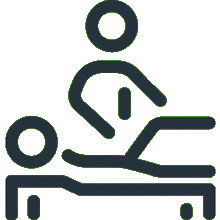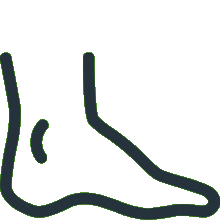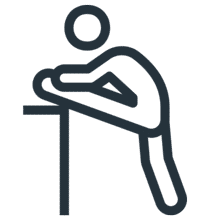So naturally, the topic of whether or not to have surgery, is a topic that I have developed a strong opinion of over my time as a physiotherapist and as a strength and conditioning coach. It is also a topic that has been forced upon myself, having ruptured my ACL 12 years ago (prior to commencing my current career path), and then doing so again coming off a ladder just prior to the weekend, as you can see from my MRI below.

In Australia, we have the highest rates of ACL reconstructive surgery in the world (Zbrojkiewicz, Vertullo and Grayson 2018). We all know many friends who have had one, or have had one ourselves. We see our professional sports stars in football, netball, etc. rupture their ACL, and are booked in for surgery the next week, with the expectation that they will be out of their sport for the next 9-12 months. This familiar script repeatedly unfolds in front of us. So then when it happens to us, and often our physios, GPs, sports physicians and specialists are all suggesting this is the best path for us, many of us accept it as an inevitability and don’t question whether there is an alternative path for us to choose. That was certainly the case for myself 12 years ago, prior to knowing what I know now. And I have spoken to countless others in the same boat since.
However, if you happened to reside in another country, you are less likely to come to the same decision. So something doesn’t quite add up here. My strong belief is that for many athletes, surgery may not present as a necessary option, or as the best option. And for most of those athletes, they are making huge decisions for themselves without being presented with all of the available information. My goal is for all of our athletes to make the best decision for themselves, relative to their own situation, coming from a fully informed platform. Hopefully this blog is taking one small step towards achieving that.
ELITE LEVEL CASE STUDY
Recently an English Premier League footballer ruptured the Anterior Cruciate Ligament (ACL) in his knee, opted against having surgery, completed his rehabilitation, and subsequently returned to play in just 8 weeks. He also suffered no complications following his return to play over the following 18 months (Weiler et al., 2015). This was certainly not the first professional or amateur athlete to return to a pivoting/cutting sport minus an ACL, but it has helped foster a lot of discussion around whether ACL reconstructive surgery is essential for athletes returning to sport at any level. It has drawn a lot of attention as it was officially documented in the literature, but also due to its impressively short turnaround.
This footballer was just one case, and we should not draw too much from this case alone. For every footballer that has successfully returned with or without an ACL, there will be many others that have not. But it does highlight to many that having an ACL reconstruction may not be as essential as they once believed, and they may be able to fulfil their goals without it.
RESEARCH EVIDENCE: REHAB VS SURGERY
So now that the spotlight is on, let’s have a look at the literature to see what research is showing. Currently, there has only been one Randomised Controlled Trial comparing ACL reconstructive surgery + rehabilitation, with rehabilitation alone. This trial was labelled the KANON trial (Frobell et al., 2013). In this trial, 121 active adults aged 18-35 were randomly allocated to a surgery + rehabilitation group or a rehabilitation alone group. In this study, the participants who entered the rehabilitation alone group were provided the option of having ACL surgery at a later date if they chose to, for whatever reason.
These participants were followed for 5 years after entering the trial. At the conclusion of that 5 year follow up period, no differences were observed between the surgical + rehabilitation arm and the rehabilitation arm with respect to activity and functional levels, complications or osteoarthritic changes.
But these groups can be broken down even further. Within the rehabilitation arm, 50% of those athletes did choose to go down the surgical path at a later date. At 5 year follow up, no differences were observed between the surgical arm, the delayed surgical arm, or the rehabilitation alone groups.
For me, these are the main takeaways from this study:
- If you choose to rehabilitate your knee, without surgical intervention, there is a 50% chance you will be successful in doing so. The outcomes for your knee and for your life will be the same, in comparison to having surgery.
- If you choose to have surgery, the results for your knee and your life will be the same, as if you have it tomorrow, or if you have it in 3, 6 or 12 months time.
- If you are unsure which way to go, you can give rehabilitation a 3 or 6 month trial period. Then determine whether or not you are happy with your progress. If you are not happy, you can still have surgery at any time, but there is a 50% chance you won’t need to.
RESEARCH: OSTEOARTHRITIS DEVELOPMENT
Additionally, looking at longer term outcomes, there is a belief from many in the general public that the long term prognosis for someone’s knee will be better when having ACL reconstructive surgery, due to the greater structural stability it will provide them. However, a systematic review demonstrated that findings across numerous studies have shown that the development of knee osteoarthritis is significantly greater for individuals who have injured their ACLs, but that the rates of osteoarthritis are no different if they choose to have surgery or not (Oiestad et al., 2009).
Whilst it is true the ACL surgery will afford that individual the stability of that ACL, it ignores the fact the functional stability can be successfully achieved without an ACL, and it also ignores the fact that the surgery itself is a far greater trauma on someone’s knee than the ACL injury itself, and likely itself contributes towards the development of osteoarthritis as well.
CONCLUSION
The above evidence so far demonstrates that outcomes are very similar whichever path you choose. The ideal path for each individual is going to come down to their own personal circumstances. Weighing up those options is something that should not be rushed, and I would encourage plenty of discussion amongst friends, family, and with treating medical professionals.
For many, I’m sure they still feel like the non-surgical path is not a realistic path for them, despite being presented with the above evidence. So, now having ruptured my ACL once more, I’m going to take this opportunity to demystify this process. I have chosen not to go down the surgical path. I am going to post regular updates on what I am doing to rehabilitate my knee, and demonstrate to you all what experiences can be achieved without an ACL that you may not feel is possible. My first goal, to complete a 5km run, as a part of PEAKs Dream Big Virtual Running Festival in 4 weeks time. If you are looking for your own running motivation and interested in participating, it is free, and you can register here
Dream big,
Andy McGree
PEAK Physiotherapist and Strength & Conditioning Coach
 In Australia, we have the highest rates of ACL reconstructive surgery in the world (Zbrojkiewicz, Vertullo and Grayson 2018). We all know many friends who have had one, or have had one ourselves. We see our professional sports stars in football, netball, etc. rupture their ACL, and are booked in for surgery the next week, with the expectation that they will be out of their sport for the next 9-12 months. This familiar script repeatedly unfolds in front of us. So then when it happens to us, and often our physios, GPs, sports physicians and specialists are all suggesting this is the best path for us, many of us accept it as an inevitability and don’t question whether there is an alternative path for us to choose. That was certainly the case for myself 12 years ago, prior to knowing what I know now. And I have spoken to countless others in the same boat since.However, if you happened to reside in another country, you are less likely to come to the same decision. So something doesn’t quite add up here. My strong belief is that for many athletes, surgery may not present as a necessary option, or as the best option. And for most of those athletes, they are making huge decisions for themselves without being presented with all of the available information. My goal is for all of our athletes to make the best decision for themselves, relative to their own situation, coming from a fully informed platform. Hopefully this blog is taking one small step towards achieving that.ELITE LEVEL CASE STUDYRecently an English Premier League footballer ruptured the Anterior Cruciate Ligament (ACL) in his knee, opted against having surgery, completed his rehabilitation, and subsequently returned to play in just 8 weeks. He also suffered no complications following his return to play over the following 18 months (Weiler et al., 2015). This was certainly not the first professional or amateur athlete to return to a pivoting/cutting sport minus an ACL, but it has helped foster a lot of discussion around whether ACL reconstructive surgery is essential for athletes returning to sport at any level. It has drawn a lot of attention as it was officially documented in the literature, but also due to its impressively short turnaround.This footballer was just one case, and we should not draw too much from this case alone. For every footballer that has successfully returned with or without an ACL, there will be many others that have not. But it does highlight to many that having an ACL reconstruction may not be as essential as they once believed, and they may be able to fulfil their goals without it.RESEARCH EVIDENCE: REHAB VS SURGERYSo now that the spotlight is on, let’s have a look at the literature to see what research is showing. Currently, there has only been one Randomised Controlled Trial comparing ACL reconstructive surgery + rehabilitation, with rehabilitation alone. This trial was labelled the KANON trial (Frobell et al., 2013). In this trial, 121 active adults aged 18-35 were randomly allocated to a surgery + rehabilitation group or a rehabilitation alone group. In this study, the participants who entered the rehabilitation alone group were provided the option of having ACL surgery at a later date if they chose to, for whatever reason.These participants were followed for 5 years after entering the trial. At the conclusion of that 5 year follow up period, no differences were observed between the surgical + rehabilitation arm and the rehabilitation arm with respect to activity and functional levels, complications or osteoarthritic changes.But these groups can be broken down even further. Within the rehabilitation arm, 50% of those athletes did choose to go down the surgical path at a later date. At 5 year follow up, no differences were observed between the surgical arm, the delayed surgical arm, or the rehabilitation alone groups.For me, these are the main takeaways from this study:
In Australia, we have the highest rates of ACL reconstructive surgery in the world (Zbrojkiewicz, Vertullo and Grayson 2018). We all know many friends who have had one, or have had one ourselves. We see our professional sports stars in football, netball, etc. rupture their ACL, and are booked in for surgery the next week, with the expectation that they will be out of their sport for the next 9-12 months. This familiar script repeatedly unfolds in front of us. So then when it happens to us, and often our physios, GPs, sports physicians and specialists are all suggesting this is the best path for us, many of us accept it as an inevitability and don’t question whether there is an alternative path for us to choose. That was certainly the case for myself 12 years ago, prior to knowing what I know now. And I have spoken to countless others in the same boat since.However, if you happened to reside in another country, you are less likely to come to the same decision. So something doesn’t quite add up here. My strong belief is that for many athletes, surgery may not present as a necessary option, or as the best option. And for most of those athletes, they are making huge decisions for themselves without being presented with all of the available information. My goal is for all of our athletes to make the best decision for themselves, relative to their own situation, coming from a fully informed platform. Hopefully this blog is taking one small step towards achieving that.ELITE LEVEL CASE STUDYRecently an English Premier League footballer ruptured the Anterior Cruciate Ligament (ACL) in his knee, opted against having surgery, completed his rehabilitation, and subsequently returned to play in just 8 weeks. He also suffered no complications following his return to play over the following 18 months (Weiler et al., 2015). This was certainly not the first professional or amateur athlete to return to a pivoting/cutting sport minus an ACL, but it has helped foster a lot of discussion around whether ACL reconstructive surgery is essential for athletes returning to sport at any level. It has drawn a lot of attention as it was officially documented in the literature, but also due to its impressively short turnaround.This footballer was just one case, and we should not draw too much from this case alone. For every footballer that has successfully returned with or without an ACL, there will be many others that have not. But it does highlight to many that having an ACL reconstruction may not be as essential as they once believed, and they may be able to fulfil their goals without it.RESEARCH EVIDENCE: REHAB VS SURGERYSo now that the spotlight is on, let’s have a look at the literature to see what research is showing. Currently, there has only been one Randomised Controlled Trial comparing ACL reconstructive surgery + rehabilitation, with rehabilitation alone. This trial was labelled the KANON trial (Frobell et al., 2013). In this trial, 121 active adults aged 18-35 were randomly allocated to a surgery + rehabilitation group or a rehabilitation alone group. In this study, the participants who entered the rehabilitation alone group were provided the option of having ACL surgery at a later date if they chose to, for whatever reason.These participants were followed for 5 years after entering the trial. At the conclusion of that 5 year follow up period, no differences were observed between the surgical + rehabilitation arm and the rehabilitation arm with respect to activity and functional levels, complications or osteoarthritic changes.But these groups can be broken down even further. Within the rehabilitation arm, 50% of those athletes did choose to go down the surgical path at a later date. At 5 year follow up, no differences were observed between the surgical arm, the delayed surgical arm, or the rehabilitation alone groups.For me, these are the main takeaways from this study:- If you choose to rehabilitate your knee, without surgical intervention, there is a 50% chance you will be successful in doing so. The outcomes for your knee and for your life will be the same, in comparison to having surgery.
- If you choose to have surgery, the results for your knee and your life will be the same, as if you have it tomorrow, or if you have it in 3, 6 or 12 months time.
- If you are unsure which way to go, you can give rehabilitation a 3 or 6 month trial period. Then determine whether or not you are happy with your progress. If you are not happy, you can still have surgery at any time, but there is a 50% chance you won’t need to.
Let's get started — How can we help?
Physiotherapy

Chiropractic

Podiatry

Massage Therapy

Women's Health Physiotherapy

Running Program Tailored To Your Goals

Joint Mobilisation

Active Release Technique

Exercise Prescription

Real Time Ultrasound Imaging

Spinal Manipulation

Functional Movement Screen

Knee Pain Treatment

Hamstring Strain Treatment

Hip Pain Treatment

Upper, Middle & Lower Back Pain

Neck Pain Treatment

Shoulder Pain & Rotator Cuff Tear

Can't find what you're after?
View all ServicesOr email the PEAK team at info@peakssc.com.au
Hawthorne
- Phone: (07) 3399 3318
- Fax: (07) 3319 6577
Address
5/171 Riding Road,Hawthorne, QLD, 4171 Get Directions
Opening Hours -
6 days per week
- Monday - Friday: 7:00 am - 8:00 pm
- Saturday: 7:00 am - 1:00 pm
To make a booking outside of business hours, please use our form by clicking here.
New Farm
- Phone: (07) 3399 4668
- Fax: (07) 3319 6577
Address
1/15 Lamington Street,New Farm, QLD, 4005 Get Directions
Opening Hours -
6 days per week
- Monday: 7:00 am - 8:00 pm
- Tuesday: 7:00 am - 8:00 pm
- Wednesday: 9:00 am - 8:00 pm
- Thursday: 10:00 am - 8:00 pm
- Friday: 7:00 am - 3:00 pm
- Saturday: 7:00 am - 3:00 pm
To make a booking outside of business hours, please use our form by clicking here.